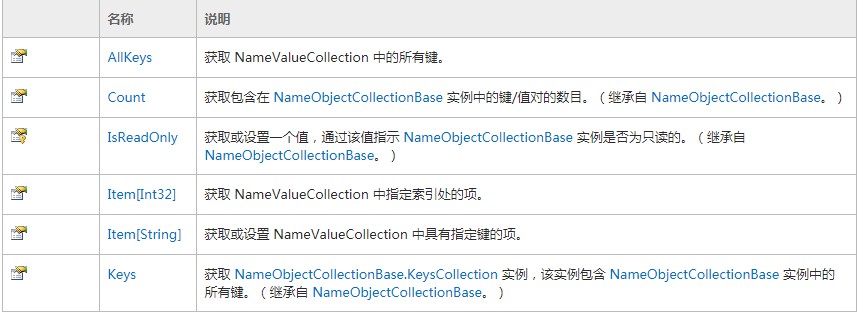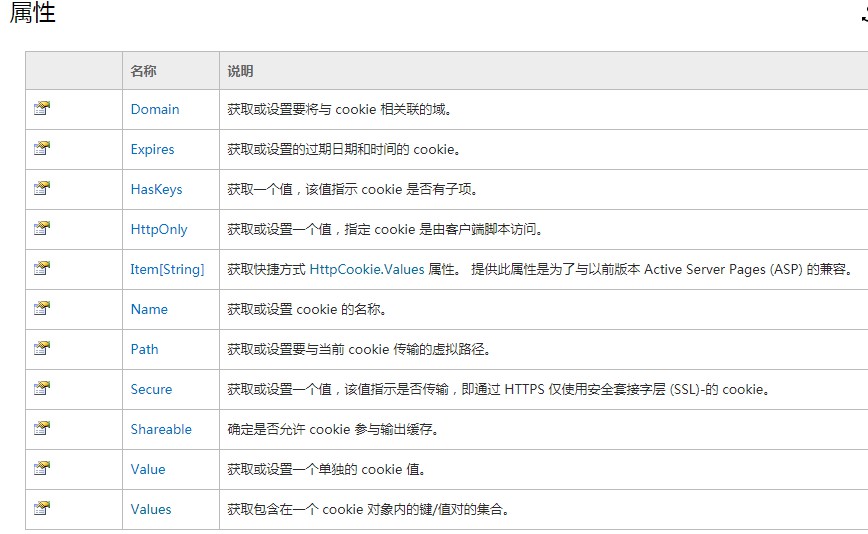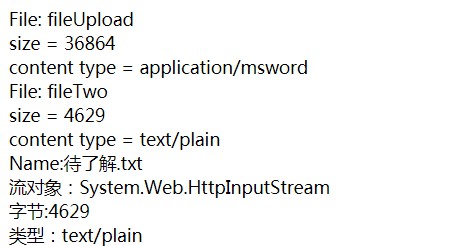HttpRequest 类
关于此类的介绍:查看HttpRequest类
点击查看:HttpRequest中方法的封装
跟这个类对应的HttpResponse类
定义:使 ASP.NET 能够读取客户端在 Web 请求期间发送的 HTTP 值。
public sealed class HttpRequest
注:本篇主要介绍可以根据这个类获取什么信息,只会介绍一些用到的方法。
你先要在引用中添加 System.Web.然后引用命名空间。
属性:




public void GetTest()
{
int loop1, loop2;
NameValueCollection coll; //System.Collections.Specialized; 命名空间下
// Load ServerVariable collection into NameValueCollection object.
coll = Request.ServerVariables;
// Get names of all keys into a string array.
String[] arr1 = coll.AllKeys;
for (loop1 = 0; loop1 < arr1.Length; loop1++)
{
Response.Write("Key: " + arr1[loop1] + "<br>");
String[] arr2 = coll.GetValues(arr1[loop1]);
for (loop2 = 0; loop2 < arr2.Length; loop2++)
{
Response.Write("Value " + loop2 + ": " + Server.HtmlEncode(arr2[loop2]) + "<br>");
}
}
}
public Uri UrlReferrer { get; }Url类简单介绍
定义: 提供统一资源标识符 (URI) 的对象表示形式和对 URI 各部分的轻松访问。


属性: 截取一部分属性
返回字符串类型



测试:
页面1有一个连接到页面2去
<asp:LinkButton ID="LinkButton1" runat="server" PostBackUrl="~/TestDemo/WebForm2.aspx">LinkButton</asp:LinkButton>
页面2的加载事件把上一个URL信息输出
protected void Page_Load(object sender, EventArgs e)
{
Uri MyUrl = Request.UrlReferrer;
Response.Write("Referrer URL: " + Server.HtmlEncode(MyUrl.AbsoluteUri) + "<br>");
Response.Write("Referrer URL Port: " + Server.HtmlEncode(MyUrl.Port.ToString()) + "<br>");
Response.Write("Referrer URL Protocol: " + Server.HtmlEncode(MyUrl.Scheme) + "<br>");
Response.Write("Referrer URL: " + Server.HtmlEncode(MyUrl.Query) + "<br>");
}
传参是一样的(需要使用get传参)
用途:
使用这个很好的可以解决我们登入返回登入页面的问题。登入返回登入前的页面还可以使用Session解决,在登入前把页面信息都保存起来,登入成功后在读取出来。
注:需要在登入页面的加载事件把上一个URL用字符串存起来,登入成功了,跳转这个字符串。(写了登入事件,点击的时候会让页面刷新,上一个页面就是本事页面了)
解决方法:
string beforeURL = ""; //第一次进入的时候把之前的页面存起来
protected void Page_Load(object sender, EventArgs e)
{
if (!IsPostBack)
{
if (Request.UrlReferrer != null) //如果这个页面是第一个打开的,这个值为空
{
beforeURL = Request.UrlReferrer.ToString();
}
}
} if (beforeURL!="")
{
Response.Redirect(beforeURL);
}
else
{
Response.Redirect("HomePage/Index.aspx");
}这三个都是返回字符串类型


备注:原始 URL 被指以下域信息的 URL 的一部分。在 URL 字符串 http://www.contoso.com/articles/recent.aspx,原始的 URL 是 /articles/recent.aspx。如果存在,原始的 URL 包括查询字符串。
Response.Write("Referrer1: " + Server.HtmlEncode(Request.PhysicalApplicationPath) + "<br>");
Response.Write("Referrer2: " + Server.HtmlEncode(Request.PhysicalPath) + "<br>");
Response.Write("Referrer URL: " + Server.HtmlEncode(Request.RawUrl) + "<br>");


属性:

Response.Write("Type: " + Server.HtmlEncode(Request.Browser.Type) + "<br>");

Response.Write("Url: " + Server.HtmlEncode(Request.Url.ToString()) + "<br>");Url: http://localhost:4265/TestDemo/WebForm1.aspx?data=1&ke=good


get传参
string fullname1 = Request.QueryString["fullname"]; //返回的是string类型 string fullname2 = Request["fullname"];
第一行代码会查找键"fullname"仅在查询字符串中;第二行中查找"fullname"中的所有 HTTP 请求集合的键。
HttpRequest.Item 属性 (String)
从QueryString、Form、Cookies或ServerVariables集合获取指定的对象。
Type:System.Collections.Specialized.NameValueCollection
NameValueCollection 类
表示可通过键或索引访问的关联String键和String值的集合。



post传参
Form和QueryString是一样的,都可以使用下面的方法获取都有的健和值
int loop1 = 0;
NameValueCollection coll = Request.QueryString; //注意引用命名空间
string[] arr1 = coll.AllKeys;
for (loop1 = 0; loop1 < arr1.Length; loop1++)
{
Response.Write("Form: " + arr1[loop1] + ",Vlue:"+ Request.QueryString[arr1[loop1]] + "<br>");
}


protected void Page_Load(object sender, EventArgs e)
{
int loop1, loop2;
NameValueCollection coll;
// Load Header collection into NameValueCollection object.
coll = Request.Headers;
// Put the names of all keys into a string array.
String[] arr1 = coll.AllKeys;
for (loop1 = 0; loop1 < arr1.Length; loop1++)
{
Response.Write("Key: " + arr1[loop1] + "<br>");
// Get all values under this key.
String[] arr2 = coll.GetValues(arr1[loop1]);
for (loop2 = 0; loop2 < arr2.Length; loop2++)
{
Response.Write("Value " + loop2 + ": " + Server.HtmlEncode(arr2[loop2]) + "<br>");
}
}
}


Request.Cookies["XX"];//返回的是HttpCookie类
HttpCookie 类
提供以类型安全的方式来创建和操作单个 HTTP cookie。
命名空间:System.Web


简单的设想Cookies
设置一个Cookies
Response.Cookies["one"].Value =Server.UrlEncode("我的Cookie值"); //要存储中文需要编码获取一个Cookies
Response.Write(Server.UrlDecode(Request.Cookies["one"].Value) +"<br>");//进行解码
还可以在一个Cookies里面设置多个健
HttpCookie myCookie = new HttpCookie("two");
myCookie.Values["Name"] = "li";//中文编码
myCookie.Values["Age"] = "18";
Response.Cookies.Add(myCookie); Response.Write(Request.Cookies["two"].Value+"<br>");
Response.Write(Request.Cookies["two"].Values + "<br>");
Response.Write(Request.Cookies["two"].Values["Name"] + "<br>");
Response.Write(Request.Cookies["two"]["Age"] + "<br>");
调用封装的方法:
HttpRequestC.WriteCookie("one", "我的Cookied值");
HttpRequestC.WriteCookie("two", "li", "Name");
HttpRequestC.WriteCookie("two", "187", "Age"); Response.Write(HttpRequestC.GetCookie("one")+"<br>");
Response.Write(HttpRequestC.GetCookie("two","Name") + "<br>");
Response.Write(HttpRequestC.GetCookie("two", "Age") + "<br>");
Request.Params["xxx"];//通用方法



HttpFileCollection.Item 属性 (String)

HttpPostedFile 类
提供已上载的客户端的各个文件的访问权限。

<asp:FileUpload ID="fileUpload" runat="server" />
<asp:FileUpload ID="fileTwo" runat="server" /> protected void LinkButton1_Click(object sender, EventArgs e)
{
int loop1;
HttpFileCollection Files = Request.Files;
string[] arr1 = Files.AllKeys;
for (loop1 = 0; loop1 < arr1.Length; loop1++)
{
Response.Write("File: " + Server.HtmlEncode(arr1[loop1]) + "<br />");
Response.Write(" size = " + Files[loop1].ContentLength + "<br />");
Response.Write(" content type = " + Files[loop1].ContentType + "<br />");
}
HttpPostedFile pf = Request.Files["fileTwo"];
Response.Write("Name:"+pf.FileName+"<br>");
Response.Write("流对象:"+pf.InputStream + "<br>");
Response.Write("字节:"+pf.ContentLength + "<br>");
Response.Write("类型:"+pf.ContentType + "<br>");
}
基本介绍就到这了。
以上就是本文的全部内容,希望对大家的学习有所帮助,也希望大家多多支持好代码网。
